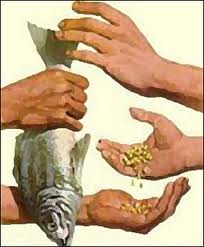How To Slay Demons
If there is one book that I
wish everyone (or at least, a great number) would read, it would be Carl Sagan’s
The Demon-Haunted World.
 |
| Carl Sagan, with a model of the Viking lander |
I visited several bookstores
a few months ago looking for a copy, but I did not find any. The bookstores I
visited all had prominent displays of those “Shades of Grey” books, and many, many
editions and translations of the Bible (you really can’t miss those two), but no
Carl Sagan books, unfortunately.
Or any other sciencey books, for that matter.
Carl Sagan was an American astrophysicist
who popularized science and promoted scientific thinking in his books.
Published in 1995, “The Demon-Haunted World” is one of those books that the
rather trite expression “eye-opener” applies perfectly. The book promotes critical
thinking to be applied in everything, to help people avoid being bamboozled by charlatans and crackpots (like the people on this list) who deceive and hoodwink others.
It
helps us know the difference between valid
science and pseudoscience, between casuistry and sound reasoning, and keeps us from
being gullible and to have a healthy dose of skepticism.
Critical thinking enables us to escape
the gravity pull of superstition that keeps us mired in stupidity and
ignorance.
Carl Sagan's “Baloney Detection Kit” comes highly
recommended and is very useful in slaying "demons" (don't leave home without it!):
§ Seek independent confirmation of alleged facts.
§ Encourage an open debate about the issue and the available evidence.
§ "In science, there are no authorities. At most, there are
experts."
§ Come up with a variety of competing hypotheses explaining a given
outcome. Considering many different explanations will lower the risk of
confirmation bias.
§ Don't get too attached to your own ideas, lest you get reluctant to
reject them even in the face of evidence to the contrary.
§ Quantify whenever possible, allowing for easier comparisons between
hypotheses' relative explanatory power.
§ Every step in an argument must be logically sound; a single weak link
can doom the entire chain.
§ Pay attention to falsifiability.
Science does not concern itself with unfalsifiable propositions.
The book also has a list of
common logical and rhetorical fallacies:
- Ad hominem -
attacking the arguer and not the argument.
- Argument from "authority".
- Argument from adverse consequences (putting pressure on the
decision maker by pointing out dire consequences of an
"unfavorable" decision).
- Appeal to ignorance (absence of evidence is not evidence of
absence).
- Special pleading (typically referring to god's will).
- Begging the question (assuming an answer in the way the question
is phrased).
- Observational selection (counting the hits and forgetting the
misses).
- Statistics of small numbers (such as drawing conclusions from
inadequate sample sizes).
- Misunderstanding the nature of statistics (Majority of people in Manila die in hospitals; therefore stay out of hospitals! )
- Inconsistency (When two propositions are asserted that cannot both possibly be true).
- Non sequitur -
"it does not follow" - the logic falls down.
- Post hoc, ergo propter hoc -
"it happened after so it was caused by" - confusion of cause
and effect.
- Meaningless question ("what happens when an irresistible
force meets an immovable object?).
- Excluded middle - considering only the two extremes in a range of
possibilities (making the "other side" look worse than it
really is).
- Short-term v. long-term - a subset of excluded middle ("why
pursue fundamental science when we have so huge a budget deficit?").
- Slippery slope - a subset of excluded middle - unwarranted extrapolation
of the effects (give an inch and they will take a mile).
- Confusion of correlation and causation.
- Straw man - caricaturing (or stereotyping) a position to make it
easier to attack.
- Suppressed evidence or half-truths.
- Weasel words - Broadly, any word or words used with the intention to mislead or misinform (e.g., using words like, "many people say...", "according to experts...", etc.).
If you’ve ever engaged in any debate
(especially online), you’re already familiar with some of the concepts on the
list above.
I’ll provide examples on each
one on my next post on this blog.
In the meantime, I wish you a world free of
demons and full of light.





Comments
Post a Comment
So, what do you think? Post it here: